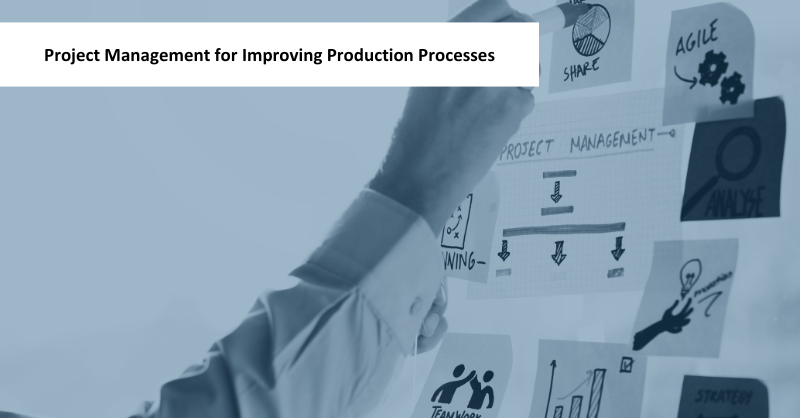Imagine a scenario where every second counts, where every resource is valuable, and where efficiency is not just a goal but a critical necessity. In a production process, even the smallest adjustment can mean the difference between success and stagnation. This is where project management comes into play—not just as an organizational tool, but as the strategic engine that drives continuous improvement. In this article, we will explore how well-executed project management can transform your production processes by optimizing every step to reach a new level of operational excellence.
Process Diagnosis: The First Step Toward Improvement
Before embarking on any improvement initiative, it’s essential to thoroughly understand the current state of production processes. A precise and exhaustive diagnosis acts as the foundation upon which all future improvements are built. Without this detailed understanding, any optimization effort risks being misdirected, addressing superficial symptoms rather than tackling the root causes of inefficiencies.
The diagnostic process begins with data collection, which may include direct observation on the plant floor, interviews with key personnel, and analysis of operational records. It is crucial to map every stage of the production process, from raw material acquisition to the delivery of the final product. This comprehensive view allows not only the identification of obvious bottlenecks but also less visible inefficiencies that might be undermining productivity.
Process Mapping
One of the most powerful tools at this stage is process mapping. This visual approach breaks down each activity into discrete components, providing a clear picture of how the various parts of the process interact. By doing so, process mapping reveals inefficient flows, duplicated efforts, and activities that add no value to the final product. This technique is not only useful for identifying current problems but also establishes a baseline against which future improvements can be measured.

KPI Analysis
In addition to process mapping, reviewing key performance indicators (KPIs) plays a crucial role in the diagnosis. KPIs provide a quantitative measure of process performance, such as cycle time, defect rates, and resource utilization. Analyzing these indicators helps identify specific areas where performance is not reaching its full potential. For instance, a prolonged cycle time may indicate bottlenecks, while a high defect rate might point to quality issues within the process.
Involving Operational Staff
Involving operational staff in the diagnosis is equally important. These workers have intimate, practical knowledge of the daily activities on the plant floor and can often offer valuable insights into problems that are not evident in the data. Their participation not only enriches the diagnosis but also facilitates acceptance and commitment to the solutions that will be implemented later.
Identifying Bottlenecks and Waste
One of the main goals of the diagnosis is to identify bottlenecks and waste within the process. Bottlenecks are points in the process that slow down the overall workflow, creating delays that affect total production. On the other hand, waste can take many forms, such as waiting time, unnecessary movement, or overproduction. Eliminating these obstacles is critical to improving efficiency and reducing operational costs.
Prioritizing Improvement Areas
With a clear diagnosis in hand, the next step is to prioritize the areas of improvement. Not all identified inefficiencies can be addressed immediately, so it is crucial to focus efforts on those that will have the greatest impact on overall performance. This prioritization should be based not only on the severity of the problem but also on the feasibility of its solution and the resources available.
In summary, process diagnosis is not just the first step toward improvement; it is a fundamental step that defines the success of the entire improvement project. By conducting a thorough diagnosis, companies can ensure they are addressing the root causes of inefficiencies, laying the groundwork for effective and lasting improvement implementation.
Strategic Project Planning for Continuous Improvement
Once a thorough diagnosis of production processes has been conducted, the next critical step is strategic project planning. This step is fundamental because the quality of the planning will largely determine the success of the implementation and the sustainability of the improvements. Strategic planning not only sets the direction of the project but also aligns the resources, time, and efforts necessary to achieve the desired goals.
Defining Clear and Measurable Objectives
The starting point of any effective strategic planning is the definition of clear and measurable objectives. These objectives must be directly aligned with the priorities identified during the process diagnosis. For example, if the diagnosis revealed that a bottleneck in production is causing significant delays, one objective could be to reduce the cycle time at that specific stage by 20% over the next six months.
Objectives must be specific, measurable, achievable, relevant, and time-bound (SMART). This not only provides a clear roadmap for the project team but also facilitates progress monitoring and evaluation of results at the end of the project.
Resource Allocation and Budget Management
Effective strategic planning also requires careful resource allocation. This includes assigning personnel, managing time, and allocating financial resources. It is vital to ensure that the necessary resources are available when needed and are used efficiently to avoid waste.
Budget management is another key component. It is essential to forecast all costs associated with the project, from materials and equipment to labor costs and any unforeseen expenses. Creating a detailed budget and closely monitoring it helps keep the project on track and within financial limits.
Selecting Suppliers and Strategic Partners
In continuous improvement project planning, selecting suppliers and strategic partners is a crucial aspect that is often overlooked. However, choosing the right suppliers can make the difference between the project’s success or failure. This is where companies like Esypro can play a decisive role.
With extensive experience in managing industrial projects, Esypro offers comprehensive intralogistics solutions that can help companies optimize their production processes. By selecting the right supplier, companies benefit not only from high-quality products but also from specialized technical support and strategic consulting that can guide the project from planning to implementation.
The selection of suppliers should be based on an evaluation of their ability to meet the project’s specific requirements, their track record of quality and compliance, and their ability to effectively collaborate with the internal team. It’s important to consider not only the cost of services and products but also the added value a reliable supplier can bring to the project.
Developing a Detailed Schedule
Developing a detailed schedule is essential for strategic planning. A well-crafted schedule allows all team members to clearly understand deadlines, tasks that need to be completed, and the milestones that must be reached at each stage of the project.
The schedule must be realistic and take into account possible delays or unforeseen circumstances. Additionally, it should include control points where progress can be evaluated and adjustments made if necessary. Project management tools like Gantt charts can be extremely helpful in visualizing the schedule and ensuring that all activities are aligned with the project’s objectives.

Risk Identification and Management
Risk management is a critical component of strategic planning. During this stage, potential risks that could affect the project’s success must be identified. These risks could be technical, financial, logistical, or human in nature.
Once risks are identified, it is essential to develop contingency plans to mitigate their impact. This includes assigning specific responsibilities within the project team to manage and respond to risks as they arise. Proactive risk management not only helps keep the project on course but also reduces the likelihood of encountering costly surprises or unexpected delays.
Alignment with Business Strategy
One of the most important aspects of strategic planning is ensuring that the improvement project is aligned with the overall business strategy. This means that the project’s objectives must significantly contribute to the organization’s broader goals, such as increasing operational efficiency, reducing costs, improving product quality, or expanding production capacity.
Strategic alignment ensures that the project not only has a positive short-term impact but also provides long-term sustainable value for the company. This also facilitates gaining support from top management and ensures that the necessary resources are available to successfully carry out the project.
Implementation of Lean and Six Sigma Methodologies
The effective implementation of a production improvement project requires adopting proven methodologies that ensure sustainable results. Lean and Six Sigma are two of the most recognized and effective methodologies in this area.
Lean focuses on eliminating waste and maximizing value for the customer. In the context of production, this means identifying and eliminating activities that do not add value, thus reducing cycle times and operational costs. The Lean philosophy promotes a culture of continuous improvement where every member of the organization is actively involved in identifying opportunities for enhancement.
Six Sigma, on the other hand, uses a data-driven approach to reduce process variability and improve quality. The DMAIC methodology (Define, Measure, Analyze, Improve, and Control) is central to Six Sigma and is applied to address specific quality problems in production. By reducing variability, companies can produce goods more consistently, which in turn improves customer satisfaction and reduces costs associated with rework and waste.
Integrating Lean and Six Sigma into project management not only improves operational efficiency but also establishes a solid framework for future improvements, ensuring that the company remains competitive in the long term.
Change Management in Production Improvement Projects
One of the biggest challenges in any improvement project is managing change. Production processes are often deeply ingrained in employees’ daily routines, and any attempt to alter them can meet resistance. Resistance to change is a natural phenomenon, but if not managed properly, it can jeopardize the project’s success.
To mitigate this resistance, it is essential to develop a change management strategy from the project’s inception. This starts with clear and continuous communication about the project’s goals, the expected benefits, and how these changes will positively impact the daily work of the team. It’s crucial that all involved understand the “why” behind the changes.
Training is another key component. Employees need to be trained on the new methodologies and tools that will be implemented. This training must be practical and relevant, allowing employees to feel confident and competent in their new tasks.
Finally, it’s crucial to have visible and active support from top management. When the organization’s leaders demonstrate their commitment to the improvement project, they send a clear message that this change is a strategic priority for the company.
Monitoring and Controlling Improvement Projects
The success of an improvement project is not only measured by its planning and implementation but also by its ability to stay on course and adapt to challenges that arise along the way. This is where monitoring and control play a crucial role.
During project execution, it is vital to have continuous monitoring mechanisms that allow for real-time progress evaluation. Project management tools, such as dashboards, enable constant tracking of milestones and KPIs defined during the planning phase. These indicators provide a clear view of whether the project is advancing as expected or if adjustments need to be made.

Controlling the project involves making proactive decisions to correct any deviations that could compromise the project’s success. This could include reallocating resources, modifying schedules, or even replanning parts of the project if significant issues are detected. The key is agility: the ability to quickly adapt to changes ensures that the project stays on track and the final objectives are achieved.
Evaluation of Results and Post-Implementation Adjustments
Once the improvements have been implemented, evaluating the results is essential to determine the project’s real impact. This evaluation must be rigorous and based on concrete data, comparing the results obtained with the objectives established at the beginning of the project.
It’s important to understand that not all improvements show immediate results. Some may require an adaptation period before the full benefits are realized. Therefore, it is advisable to carry out evaluations at different post-implementation stages to capture both short-term impacts and long-term benefits.
While the initial implementation may have achieved significant improvements, there is always room for adjustments and refinements. Continuous improvement is a cyclical process where the results of one improvement project provide the foundation for new initiatives. This ensures that the company not only maintains the improvements achieved but also continues to progress toward greater efficiency and competitiveness.
Can AI Take Over Project Management?
In the era of automation and artificial intelligence, an inevitable question arises: will there come a day when AI can manage projects entirely, replacing the need for a human Project Manager? While the idea may sound like something out of a science fiction novel, the reality is that AI is already playing an increasingly important role in project management. However, is it truly capable of replacing the human touch? Let’s explore this question.
AI in Project Management: What Can It Do?
Today, AI is revolutionizing project management, but not in the way many might imagine. AI-powered tools are exceptional at processing and analyzing large volumes of data, identifying patterns, and predicting potential problems before they become crises. For instance, predictive algorithms now allow teams to anticipate risks, optimize schedules, and allocate resources with unprecedented precision.
Additionally, AI is facilitating the automation of routine administrative tasks, such as generating status reports, tracking deadlines, and coordinating globally distributed teams. These capabilities allow project managers to focus on more strategic decisions and team dynamics management, which increases efficiency and reduces the likelihood of human error.
Human Judgment: The Irreplaceable Advantage
Despite these impressive advances, AI is still far from being able to fully replace a Project Manager. The primary reason lies in the soft skills that are essential to project management, such as strategic decision-making, conflict resolution, negotiation, and above all, empathy.
Human relationships, team motivation, and the ability to adapt to unexpected changes are areas where emotional intelligence and human judgment play a crucial role. While AI is powerful in processing data, it cannot replicate the human capacity to lead, inspire, and solve complex problems creatively.
The Future: Collaboration Between Humans and AI
Rather than viewing AI as a competitor, it is more constructive to see it as a strategic partner. The future of project management will likely be defined by close collaboration between humans and machines. AI can take over the more analytical and repetitive tasks, freeing Project Managers to focus on what they do best: making strategic decisions, leading teams, and ensuring the project is not only completed on time but also meets the broader organizational goals.
This means that project management professionals will need to develop a new skill set: mastering AI tools and refining their ability to interpret data and apply it in complex contexts. Rather than replacing project managers, AI will act as an extension of their capabilities, enabling an unprecedented level of efficiency and precision.
AI is rapidly transforming project management by offering powerful tools that automate tasks and provide data-driven insights. However, human skills such as leadership, creativity, and relationship management remain irreplaceable. The future is not about AI versus humans but about a partnership where each complements the other’s strengths. The question is no longer whether AI can manage projects for us, but how we can use it to manage projects more effectively and humanely.
Esypro: Over 35 Years of Project Management Experience
At Esypro, our story is not just a recounting of years in the industry but a testament to our unwavering commitment to excellence in internal logistics project management. For over 35 years, we have been strategic partners to companies across various industries, helping them optimize their processes and overcome the most complex challenges with reliable, customized solutions.
Our expertise extends from initial planning to implementation and follow-up, ensuring that each project is not only completed on time and within budget but also achieves its strategic objectives.

What sets Esypro apart is not just our longevity but our ability to adapt to market changes and our clients’ evolving needs. We understand that every project is unique, which is why we offer tailor-made solutions specifically designed to maximize operational efficiency and ensure a sustainable return on investment over the long term.
If you’re looking for a trusted partner with a proven track record in internal logistics solutions, Esypro is here to help. Our team of experts is ready to support you at every stage of your project, from conception to final implementation. Contact us today and discover how our experience can become your competitive advantage!
